Organisational Behaviour Report: Individual, Teams, and Culture
VerifiedAdded on 2023/02/09
|11
|3111
|25
Report
AI Summary
This report delves into key aspects of organisational behaviour, examining the impact of culture and power on individual behaviour within organisations. It evaluates both process and content theories of motivation, providing insights into what drives employees. The report further analyses the characteristics of effective and ineffective teams, highlighting the factors that contribute to their success or failure. It explores the concepts and philosophies of organisational behaviour within a broader organisational context, offering a comprehensive overview of the subject matter. The report also presents various factors which influence the work efficiency of an employee such as normative culture, fortress culture, academy culture and pragmatic culture. In positive culture all workers share their beliefs and thoughts in structure for attaining better outcomes.
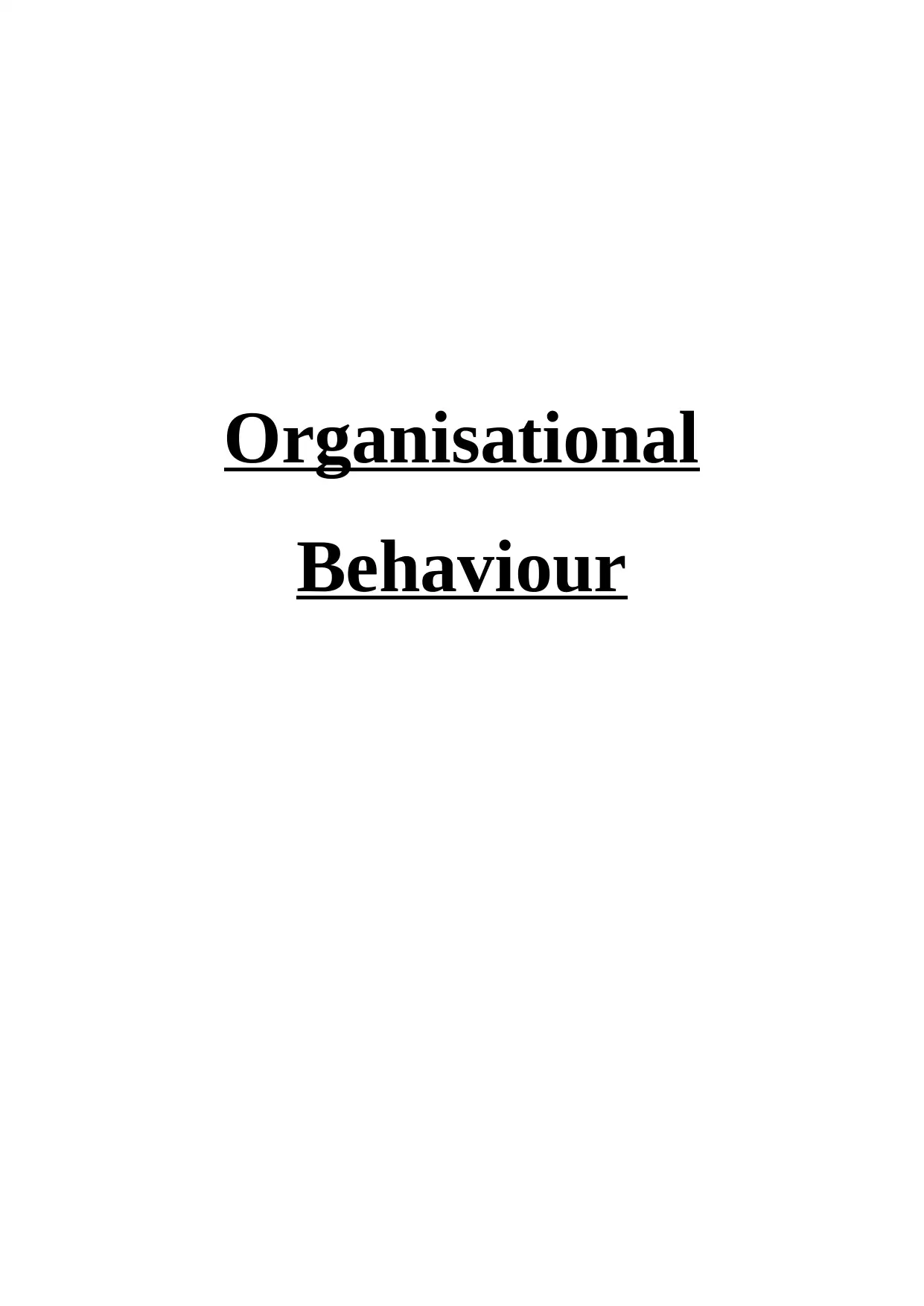
Organisational
Behaviour
Behaviour
Paraphrase This Document
Need a fresh take? Get an instant paraphrase of this document with our AI Paraphraser

Table of Contents
INTRODUCTION......................................................................................................................1
PART 1.......................................................................................................................................1
P1 Impact of culture and power of the organisation on individual behaviour.......................1
P2 Evaluation of process and content theory of motivation..................................................2
PART 2.......................................................................................................................................4
P3 Understanding of what makes an effective team and ineffective teams...........................4
P4 Concepts and philosophies of OB within organisational context.....................................6
CONCLUSION..........................................................................................................................6
REFERENCES...........................................................................................................................7
INTRODUCTION......................................................................................................................1
PART 1.......................................................................................................................................1
P1 Impact of culture and power of the organisation on individual behaviour.......................1
P2 Evaluation of process and content theory of motivation..................................................2
PART 2.......................................................................................................................................4
P3 Understanding of what makes an effective team and ineffective teams...........................4
P4 Concepts and philosophies of OB within organisational context.....................................6
CONCLUSION..........................................................................................................................6
REFERENCES...........................................................................................................................7
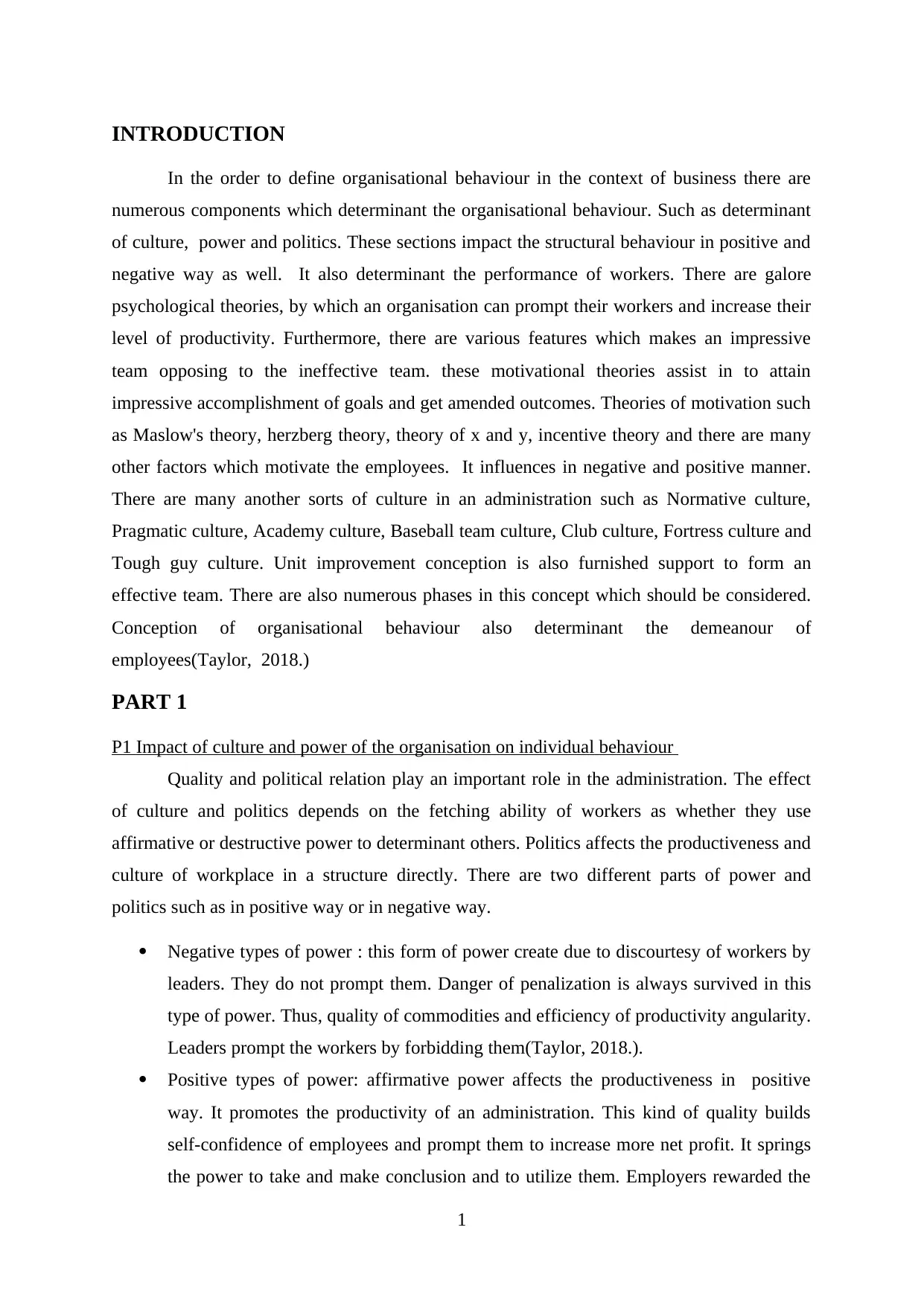
INTRODUCTION
In the order to define organisational behaviour in the context of business there are
numerous components which determinant the organisational behaviour. Such as determinant
of culture, power and politics. These sections impact the structural behaviour in positive and
negative way as well. It also determinant the performance of workers. There are galore
psychological theories, by which an organisation can prompt their workers and increase their
level of productivity. Furthermore, there are various features which makes an impressive
team opposing to the ineffective team. these motivational theories assist in to attain
impressive accomplishment of goals and get amended outcomes. Theories of motivation such
as Maslow's theory, herzberg theory, theory of x and y, incentive theory and there are many
other factors which motivate the employees. It influences in negative and positive manner.
There are many another sorts of culture in an administration such as Normative culture,
Pragmatic culture, Academy culture, Baseball team culture, Club culture, Fortress culture and
Tough guy culture. Unit improvement conception is also furnished support to form an
effective team. There are also numerous phases in this concept which should be considered.
Conception of organisational behaviour also determinant the demeanour of
employees(Taylor, 2018.)
PART 1
P1 Impact of culture and power of the organisation on individual behaviour
Quality and political relation play an important role in the administration. The effect
of culture and politics depends on the fetching ability of workers as whether they use
affirmative or destructive power to determinant others. Politics affects the productiveness and
culture of workplace in a structure directly. There are two different parts of power and
politics such as in positive way or in negative way.
Negative types of power : this form of power create due to discourtesy of workers by
leaders. They do not prompt them. Danger of penalization is always survived in this
type of power. Thus, quality of commodities and efficiency of productivity angularity.
Leaders prompt the workers by forbidding them(Taylor, 2018.).
Positive types of power: affirmative power affects the productiveness in positive
way. It promotes the productivity of an administration. This kind of quality builds
self-confidence of employees and prompt them to increase more net profit. It springs
the power to take and make conclusion and to utilize them. Employers rewarded the
1
In the order to define organisational behaviour in the context of business there are
numerous components which determinant the organisational behaviour. Such as determinant
of culture, power and politics. These sections impact the structural behaviour in positive and
negative way as well. It also determinant the performance of workers. There are galore
psychological theories, by which an organisation can prompt their workers and increase their
level of productivity. Furthermore, there are various features which makes an impressive
team opposing to the ineffective team. these motivational theories assist in to attain
impressive accomplishment of goals and get amended outcomes. Theories of motivation such
as Maslow's theory, herzberg theory, theory of x and y, incentive theory and there are many
other factors which motivate the employees. It influences in negative and positive manner.
There are many another sorts of culture in an administration such as Normative culture,
Pragmatic culture, Academy culture, Baseball team culture, Club culture, Fortress culture and
Tough guy culture. Unit improvement conception is also furnished support to form an
effective team. There are also numerous phases in this concept which should be considered.
Conception of organisational behaviour also determinant the demeanour of
employees(Taylor, 2018.)
PART 1
P1 Impact of culture and power of the organisation on individual behaviour
Quality and political relation play an important role in the administration. The effect
of culture and politics depends on the fetching ability of workers as whether they use
affirmative or destructive power to determinant others. Politics affects the productiveness and
culture of workplace in a structure directly. There are two different parts of power and
politics such as in positive way or in negative way.
Negative types of power : this form of power create due to discourtesy of workers by
leaders. They do not prompt them. Danger of penalization is always survived in this
type of power. Thus, quality of commodities and efficiency of productivity angularity.
Leaders prompt the workers by forbidding them(Taylor, 2018.).
Positive types of power: affirmative power affects the productiveness in positive
way. It promotes the productivity of an administration. This kind of quality builds
self-confidence of employees and prompt them to increase more net profit. It springs
the power to take and make conclusion and to utilize them. Employers rewarded the
1
⊘ This is a preview!⊘
Do you want full access?
Subscribe today to unlock all pages.

Trusted by 1+ million students worldwide
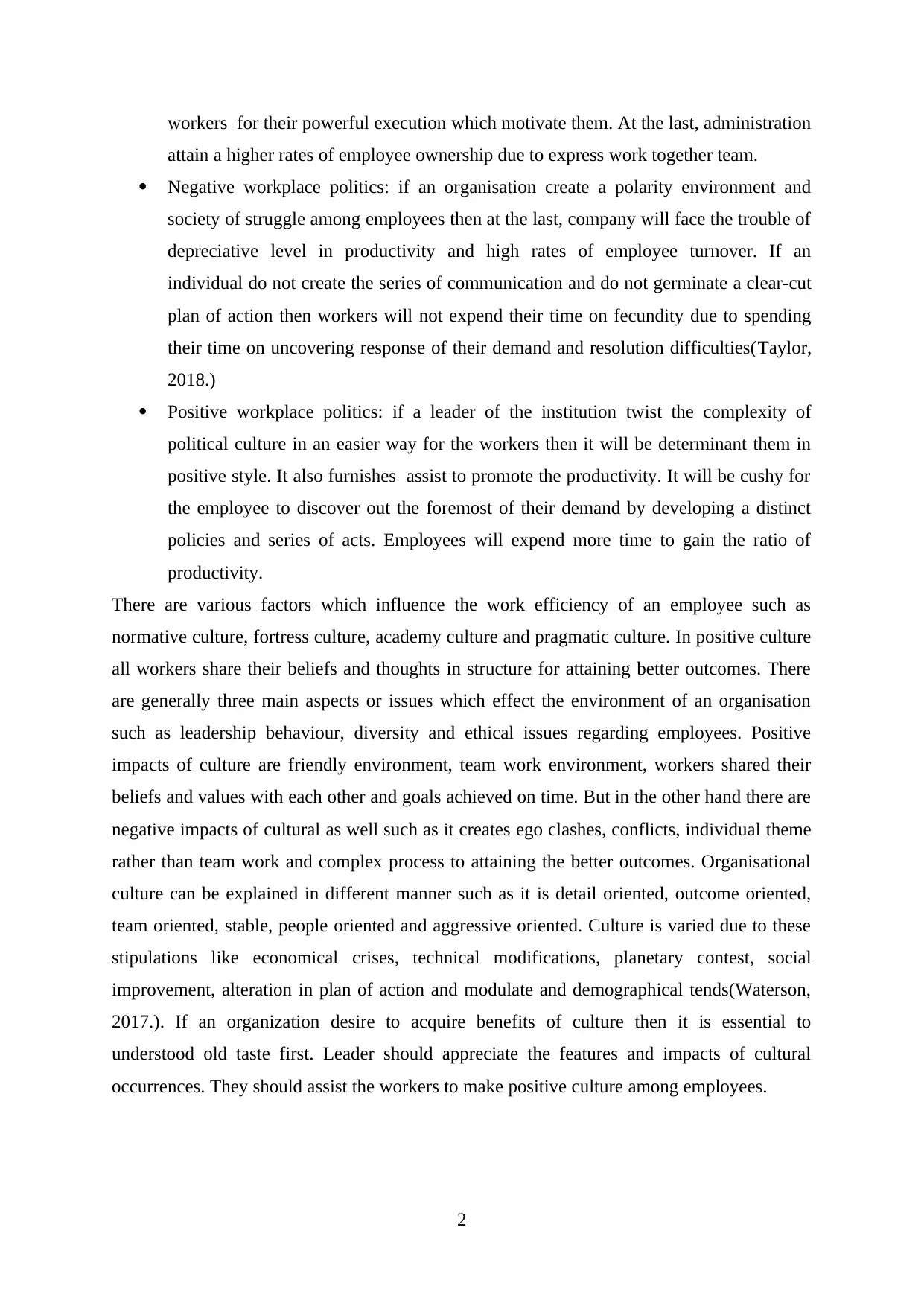
workers for their powerful execution which motivate them. At the last, administration
attain a higher rates of employee ownership due to express work together team.
Negative workplace politics: if an organisation create a polarity environment and
society of struggle among employees then at the last, company will face the trouble of
depreciative level in productivity and high rates of employee turnover. If an
individual do not create the series of communication and do not germinate a clear-cut
plan of action then workers will not expend their time on fecundity due to spending
their time on uncovering response of their demand and resolution difficulties(Taylor,
2018.)
Positive workplace politics: if a leader of the institution twist the complexity of
political culture in an easier way for the workers then it will be determinant them in
positive style. It also furnishes assist to promote the productivity. It will be cushy for
the employee to discover out the foremost of their demand by developing a distinct
policies and series of acts. Employees will expend more time to gain the ratio of
productivity.
There are various factors which influence the work efficiency of an employee such as
normative culture, fortress culture, academy culture and pragmatic culture. In positive culture
all workers share their beliefs and thoughts in structure for attaining better outcomes. There
are generally three main aspects or issues which effect the environment of an organisation
such as leadership behaviour, diversity and ethical issues regarding employees. Positive
impacts of culture are friendly environment, team work environment, workers shared their
beliefs and values with each other and goals achieved on time. But in the other hand there are
negative impacts of cultural as well such as it creates ego clashes, conflicts, individual theme
rather than team work and complex process to attaining the better outcomes. Organisational
culture can be explained in different manner such as it is detail oriented, outcome oriented,
team oriented, stable, people oriented and aggressive oriented. Culture is varied due to these
stipulations like economical crises, technical modifications, planetary contest, social
improvement, alteration in plan of action and modulate and demographical tends(Waterson,
2017.). If an organization desire to acquire benefits of culture then it is essential to
understood old taste first. Leader should appreciate the features and impacts of cultural
occurrences. They should assist the workers to make positive culture among employees.
2
attain a higher rates of employee ownership due to express work together team.
Negative workplace politics: if an organisation create a polarity environment and
society of struggle among employees then at the last, company will face the trouble of
depreciative level in productivity and high rates of employee turnover. If an
individual do not create the series of communication and do not germinate a clear-cut
plan of action then workers will not expend their time on fecundity due to spending
their time on uncovering response of their demand and resolution difficulties(Taylor,
2018.)
Positive workplace politics: if a leader of the institution twist the complexity of
political culture in an easier way for the workers then it will be determinant them in
positive style. It also furnishes assist to promote the productivity. It will be cushy for
the employee to discover out the foremost of their demand by developing a distinct
policies and series of acts. Employees will expend more time to gain the ratio of
productivity.
There are various factors which influence the work efficiency of an employee such as
normative culture, fortress culture, academy culture and pragmatic culture. In positive culture
all workers share their beliefs and thoughts in structure for attaining better outcomes. There
are generally three main aspects or issues which effect the environment of an organisation
such as leadership behaviour, diversity and ethical issues regarding employees. Positive
impacts of culture are friendly environment, team work environment, workers shared their
beliefs and values with each other and goals achieved on time. But in the other hand there are
negative impacts of cultural as well such as it creates ego clashes, conflicts, individual theme
rather than team work and complex process to attaining the better outcomes. Organisational
culture can be explained in different manner such as it is detail oriented, outcome oriented,
team oriented, stable, people oriented and aggressive oriented. Culture is varied due to these
stipulations like economical crises, technical modifications, planetary contest, social
improvement, alteration in plan of action and modulate and demographical tends(Waterson,
2017.). If an organization desire to acquire benefits of culture then it is essential to
understood old taste first. Leader should appreciate the features and impacts of cultural
occurrences. They should assist the workers to make positive culture among employees.
2
Paraphrase This Document
Need a fresh take? Get an instant paraphrase of this document with our AI Paraphraser
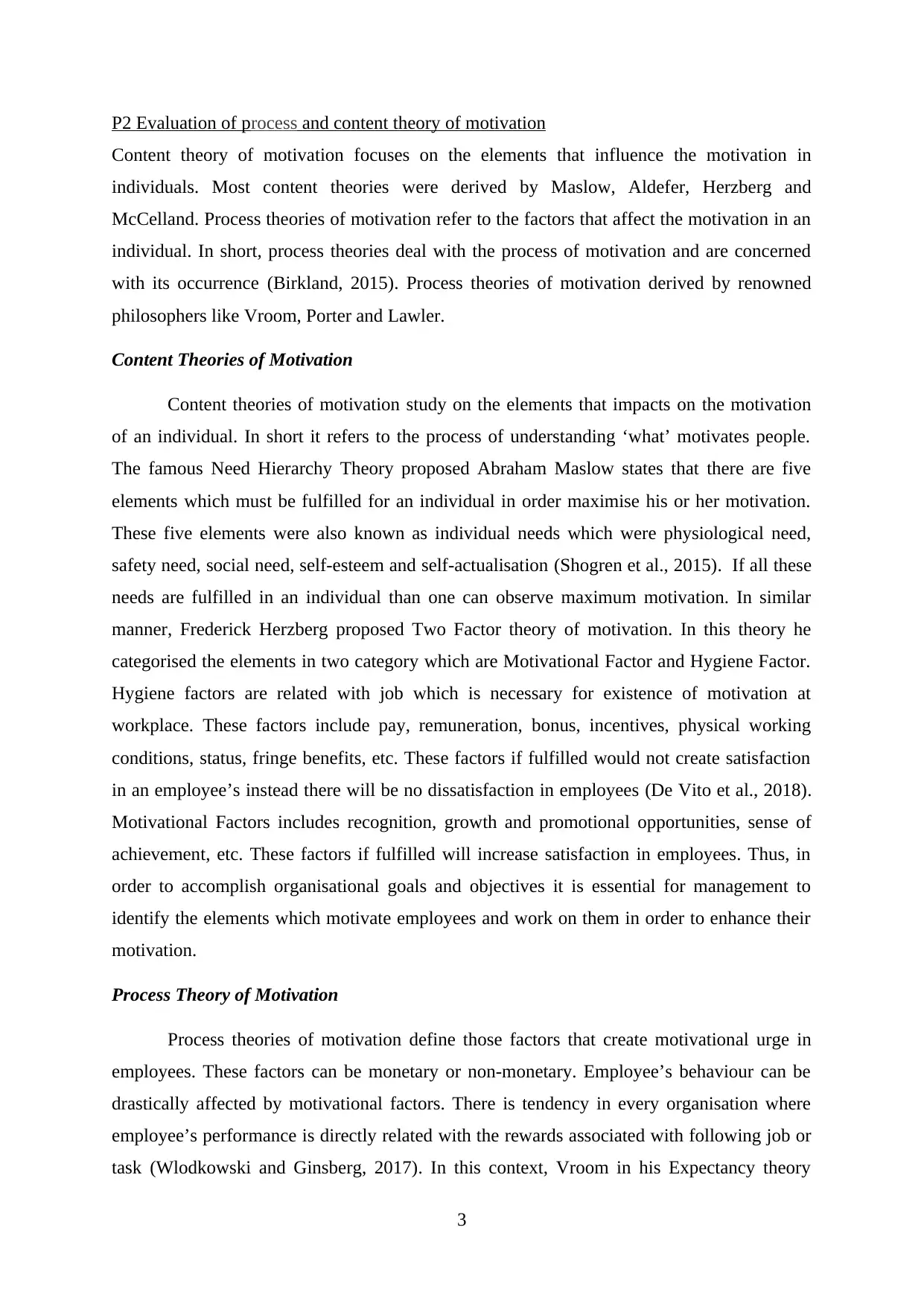
P2 Evaluation of process and content theory of motivation
Content theory of motivation focuses on the elements that influence the motivation in
individuals. Most content theories were derived by Maslow, Aldefer, Herzberg and
McCelland. Process theories of motivation refer to the factors that affect the motivation in an
individual. In short, process theories deal with the process of motivation and are concerned
with its occurrence (Birkland, 2015). Process theories of motivation derived by renowned
philosophers like Vroom, Porter and Lawler.
Content Theories of Motivation
Content theories of motivation study on the elements that impacts on the motivation
of an individual. In short it refers to the process of understanding ‘what’ motivates people.
The famous Need Hierarchy Theory proposed Abraham Maslow states that there are five
elements which must be fulfilled for an individual in order maximise his or her motivation.
These five elements were also known as individual needs which were physiological need,
safety need, social need, self-esteem and self-actualisation (Shogren et al., 2015). If all these
needs are fulfilled in an individual than one can observe maximum motivation. In similar
manner, Frederick Herzberg proposed Two Factor theory of motivation. In this theory he
categorised the elements in two category which are Motivational Factor and Hygiene Factor.
Hygiene factors are related with job which is necessary for existence of motivation at
workplace. These factors include pay, remuneration, bonus, incentives, physical working
conditions, status, fringe benefits, etc. These factors if fulfilled would not create satisfaction
in an employee’s instead there will be no dissatisfaction in employees (De Vito et al., 2018).
Motivational Factors includes recognition, growth and promotional opportunities, sense of
achievement, etc. These factors if fulfilled will increase satisfaction in employees. Thus, in
order to accomplish organisational goals and objectives it is essential for management to
identify the elements which motivate employees and work on them in order to enhance their
motivation.
Process Theory of Motivation
Process theories of motivation define those factors that create motivational urge in
employees. These factors can be monetary or non-monetary. Employee’s behaviour can be
drastically affected by motivational factors. There is tendency in every organisation where
employee’s performance is directly related with the rewards associated with following job or
task (Wlodkowski and Ginsberg, 2017). In this context, Vroom in his Expectancy theory
3
Content theory of motivation focuses on the elements that influence the motivation in
individuals. Most content theories were derived by Maslow, Aldefer, Herzberg and
McCelland. Process theories of motivation refer to the factors that affect the motivation in an
individual. In short, process theories deal with the process of motivation and are concerned
with its occurrence (Birkland, 2015). Process theories of motivation derived by renowned
philosophers like Vroom, Porter and Lawler.
Content Theories of Motivation
Content theories of motivation study on the elements that impacts on the motivation
of an individual. In short it refers to the process of understanding ‘what’ motivates people.
The famous Need Hierarchy Theory proposed Abraham Maslow states that there are five
elements which must be fulfilled for an individual in order maximise his or her motivation.
These five elements were also known as individual needs which were physiological need,
safety need, social need, self-esteem and self-actualisation (Shogren et al., 2015). If all these
needs are fulfilled in an individual than one can observe maximum motivation. In similar
manner, Frederick Herzberg proposed Two Factor theory of motivation. In this theory he
categorised the elements in two category which are Motivational Factor and Hygiene Factor.
Hygiene factors are related with job which is necessary for existence of motivation at
workplace. These factors include pay, remuneration, bonus, incentives, physical working
conditions, status, fringe benefits, etc. These factors if fulfilled would not create satisfaction
in an employee’s instead there will be no dissatisfaction in employees (De Vito et al., 2018).
Motivational Factors includes recognition, growth and promotional opportunities, sense of
achievement, etc. These factors if fulfilled will increase satisfaction in employees. Thus, in
order to accomplish organisational goals and objectives it is essential for management to
identify the elements which motivate employees and work on them in order to enhance their
motivation.
Process Theory of Motivation
Process theories of motivation define those factors that create motivational urge in
employees. These factors can be monetary or non-monetary. Employee’s behaviour can be
drastically affected by motivational factors. There is tendency in every organisation where
employee’s performance is directly related with the rewards associated with following job or
task (Wlodkowski and Ginsberg, 2017). In this context, Vroom in his Expectancy theory
3
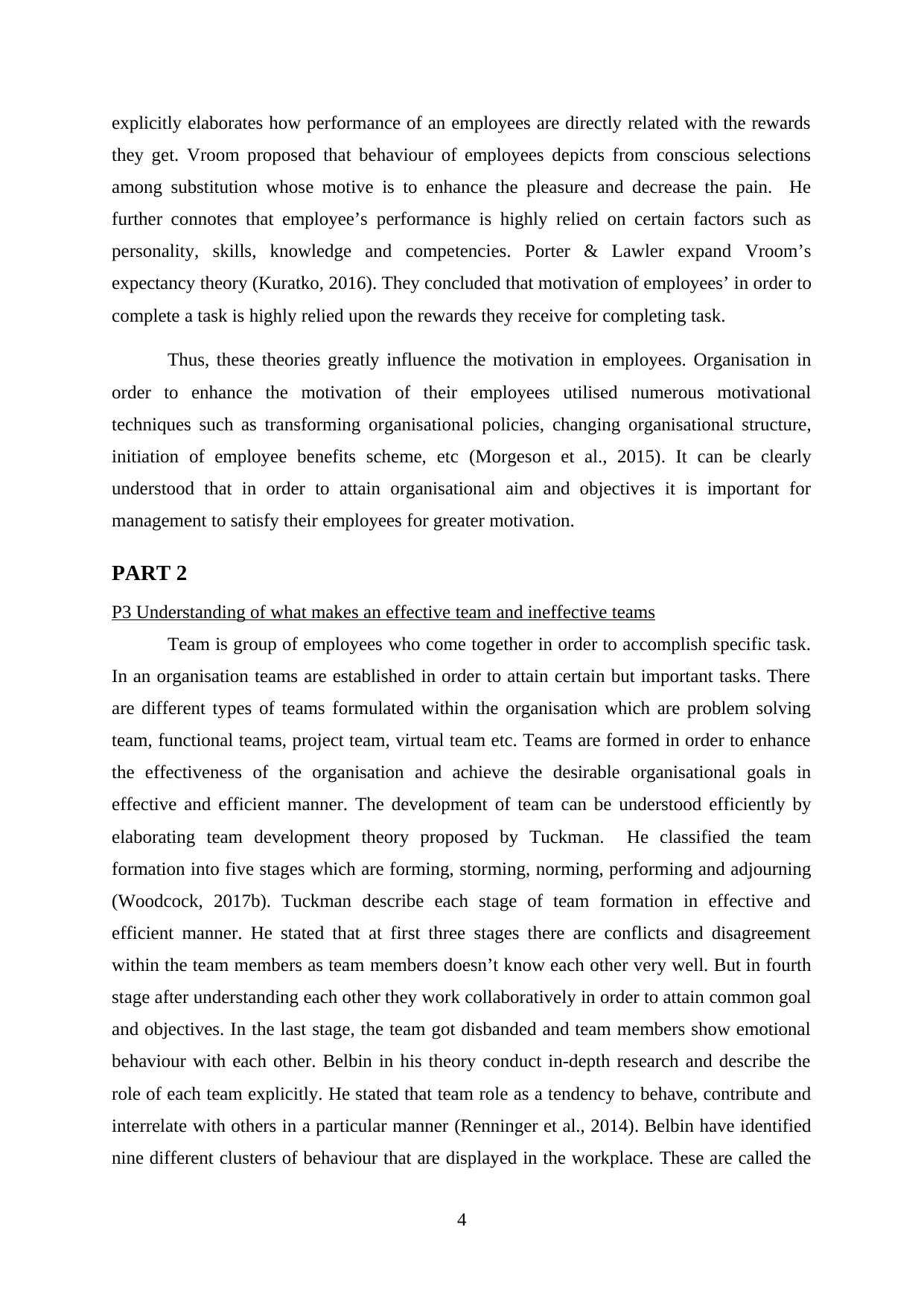
explicitly elaborates how performance of an employees are directly related with the rewards
they get. Vroom proposed that behaviour of employees depicts from conscious selections
among substitution whose motive is to enhance the pleasure and decrease the pain. He
further connotes that employee’s performance is highly relied on certain factors such as
personality, skills, knowledge and competencies. Porter & Lawler expand Vroom’s
expectancy theory (Kuratko, 2016). They concluded that motivation of employees’ in order to
complete a task is highly relied upon the rewards they receive for completing task.
Thus, these theories greatly influence the motivation in employees. Organisation in
order to enhance the motivation of their employees utilised numerous motivational
techniques such as transforming organisational policies, changing organisational structure,
initiation of employee benefits scheme, etc (Morgeson et al., 2015). It can be clearly
understood that in order to attain organisational aim and objectives it is important for
management to satisfy their employees for greater motivation.
PART 2
P3 Understanding of what makes an effective team and ineffective teams
Team is group of employees who come together in order to accomplish specific task.
In an organisation teams are established in order to attain certain but important tasks. There
are different types of teams formulated within the organisation which are problem solving
team, functional teams, project team, virtual team etc. Teams are formed in order to enhance
the effectiveness of the organisation and achieve the desirable organisational goals in
effective and efficient manner. The development of team can be understood efficiently by
elaborating team development theory proposed by Tuckman. He classified the team
formation into five stages which are forming, storming, norming, performing and adjourning
(Woodcock, 2017b). Tuckman describe each stage of team formation in effective and
efficient manner. He stated that at first three stages there are conflicts and disagreement
within the team members as team members doesn’t know each other very well. But in fourth
stage after understanding each other they work collaboratively in order to attain common goal
and objectives. In the last stage, the team got disbanded and team members show emotional
behaviour with each other. Belbin in his theory conduct in-depth research and describe the
role of each team explicitly. He stated that team role as a tendency to behave, contribute and
interrelate with others in a particular manner (Renninger et al., 2014). Belbin have identified
nine different clusters of behaviour that are displayed in the workplace. These are called the
4
they get. Vroom proposed that behaviour of employees depicts from conscious selections
among substitution whose motive is to enhance the pleasure and decrease the pain. He
further connotes that employee’s performance is highly relied on certain factors such as
personality, skills, knowledge and competencies. Porter & Lawler expand Vroom’s
expectancy theory (Kuratko, 2016). They concluded that motivation of employees’ in order to
complete a task is highly relied upon the rewards they receive for completing task.
Thus, these theories greatly influence the motivation in employees. Organisation in
order to enhance the motivation of their employees utilised numerous motivational
techniques such as transforming organisational policies, changing organisational structure,
initiation of employee benefits scheme, etc (Morgeson et al., 2015). It can be clearly
understood that in order to attain organisational aim and objectives it is important for
management to satisfy their employees for greater motivation.
PART 2
P3 Understanding of what makes an effective team and ineffective teams
Team is group of employees who come together in order to accomplish specific task.
In an organisation teams are established in order to attain certain but important tasks. There
are different types of teams formulated within the organisation which are problem solving
team, functional teams, project team, virtual team etc. Teams are formed in order to enhance
the effectiveness of the organisation and achieve the desirable organisational goals in
effective and efficient manner. The development of team can be understood efficiently by
elaborating team development theory proposed by Tuckman. He classified the team
formation into five stages which are forming, storming, norming, performing and adjourning
(Woodcock, 2017b). Tuckman describe each stage of team formation in effective and
efficient manner. He stated that at first three stages there are conflicts and disagreement
within the team members as team members doesn’t know each other very well. But in fourth
stage after understanding each other they work collaboratively in order to attain common goal
and objectives. In the last stage, the team got disbanded and team members show emotional
behaviour with each other. Belbin in his theory conduct in-depth research and describe the
role of each team explicitly. He stated that team role as a tendency to behave, contribute and
interrelate with others in a particular manner (Renninger et al., 2014). Belbin have identified
nine different clusters of behaviour that are displayed in the workplace. These are called the
4
⊘ This is a preview!⊘
Do you want full access?
Subscribe today to unlock all pages.

Trusted by 1+ million students worldwide
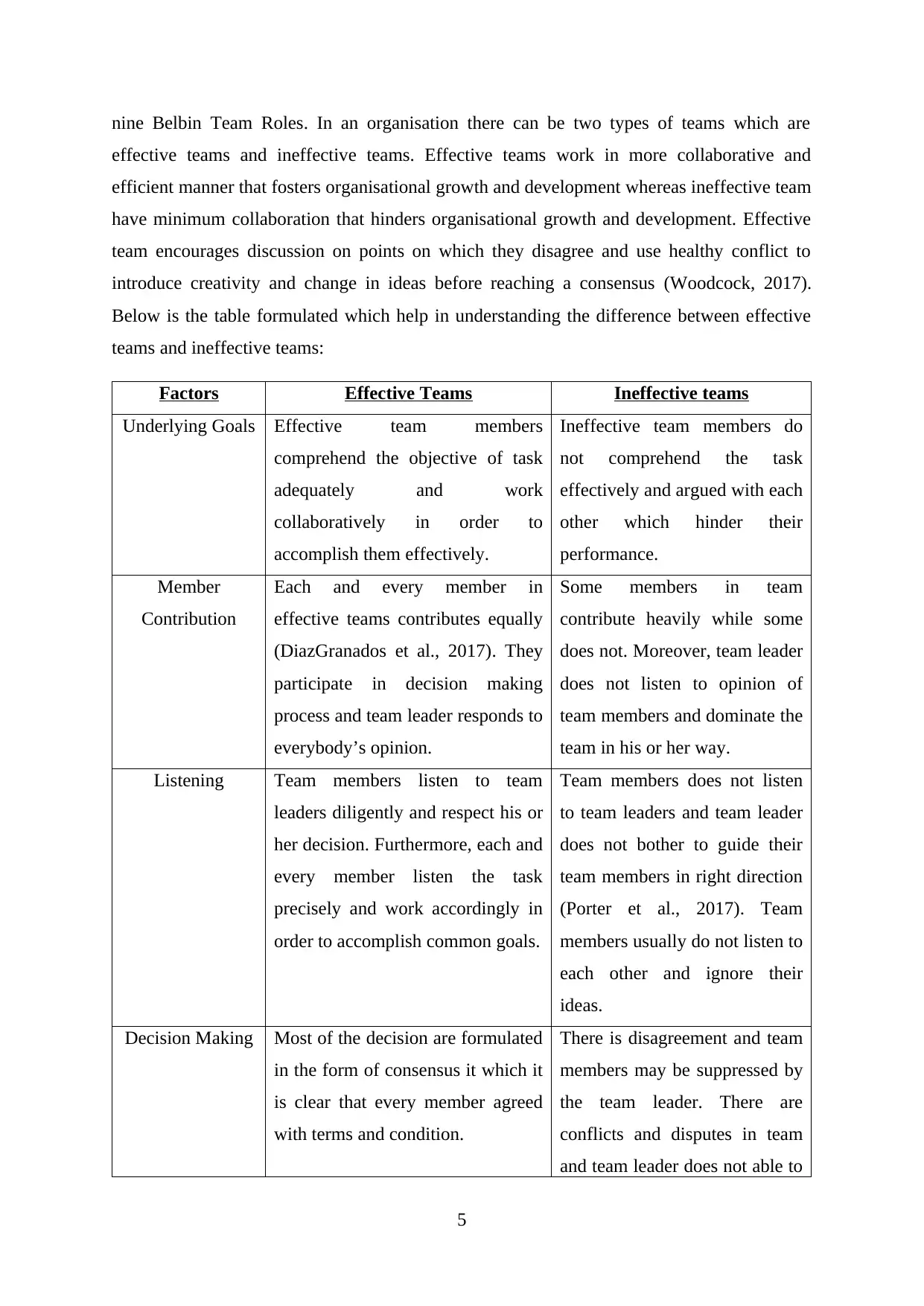
nine Belbin Team Roles. In an organisation there can be two types of teams which are
effective teams and ineffective teams. Effective teams work in more collaborative and
efficient manner that fosters organisational growth and development whereas ineffective team
have minimum collaboration that hinders organisational growth and development. Effective
team encourages discussion on points on which they disagree and use healthy conflict to
introduce creativity and change in ideas before reaching a consensus (Woodcock, 2017).
Below is the table formulated which help in understanding the difference between effective
teams and ineffective teams:
Factors Effective Teams Ineffective teams
Underlying Goals Effective team members
comprehend the objective of task
adequately and work
collaboratively in order to
accomplish them effectively.
Ineffective team members do
not comprehend the task
effectively and argued with each
other which hinder their
performance.
Member
Contribution
Each and every member in
effective teams contributes equally
(DiazGranados et al., 2017). They
participate in decision making
process and team leader responds to
everybody’s opinion.
Some members in team
contribute heavily while some
does not. Moreover, team leader
does not listen to opinion of
team members and dominate the
team in his or her way.
Listening Team members listen to team
leaders diligently and respect his or
her decision. Furthermore, each and
every member listen the task
precisely and work accordingly in
order to accomplish common goals.
Team members does not listen
to team leaders and team leader
does not bother to guide their
team members in right direction
(Porter et al., 2017). Team
members usually do not listen to
each other and ignore their
ideas.
Decision Making Most of the decision are formulated
in the form of consensus it which it
is clear that every member agreed
with terms and condition.
There is disagreement and team
members may be suppressed by
the team leader. There are
conflicts and disputes in team
and team leader does not able to
5
effective teams and ineffective teams. Effective teams work in more collaborative and
efficient manner that fosters organisational growth and development whereas ineffective team
have minimum collaboration that hinders organisational growth and development. Effective
team encourages discussion on points on which they disagree and use healthy conflict to
introduce creativity and change in ideas before reaching a consensus (Woodcock, 2017).
Below is the table formulated which help in understanding the difference between effective
teams and ineffective teams:
Factors Effective Teams Ineffective teams
Underlying Goals Effective team members
comprehend the objective of task
adequately and work
collaboratively in order to
accomplish them effectively.
Ineffective team members do
not comprehend the task
effectively and argued with each
other which hinder their
performance.
Member
Contribution
Each and every member in
effective teams contributes equally
(DiazGranados et al., 2017). They
participate in decision making
process and team leader responds to
everybody’s opinion.
Some members in team
contribute heavily while some
does not. Moreover, team leader
does not listen to opinion of
team members and dominate the
team in his or her way.
Listening Team members listen to team
leaders diligently and respect his or
her decision. Furthermore, each and
every member listen the task
precisely and work accordingly in
order to accomplish common goals.
Team members does not listen
to team leaders and team leader
does not bother to guide their
team members in right direction
(Porter et al., 2017). Team
members usually do not listen to
each other and ignore their
ideas.
Decision Making Most of the decision are formulated
in the form of consensus it which it
is clear that every member agreed
with terms and condition.
There is disagreement and team
members may be suppressed by
the team leader. There are
conflicts and disputes in team
and team leader does not able to
5
Paraphrase This Document
Need a fresh take? Get an instant paraphrase of this document with our AI Paraphraser
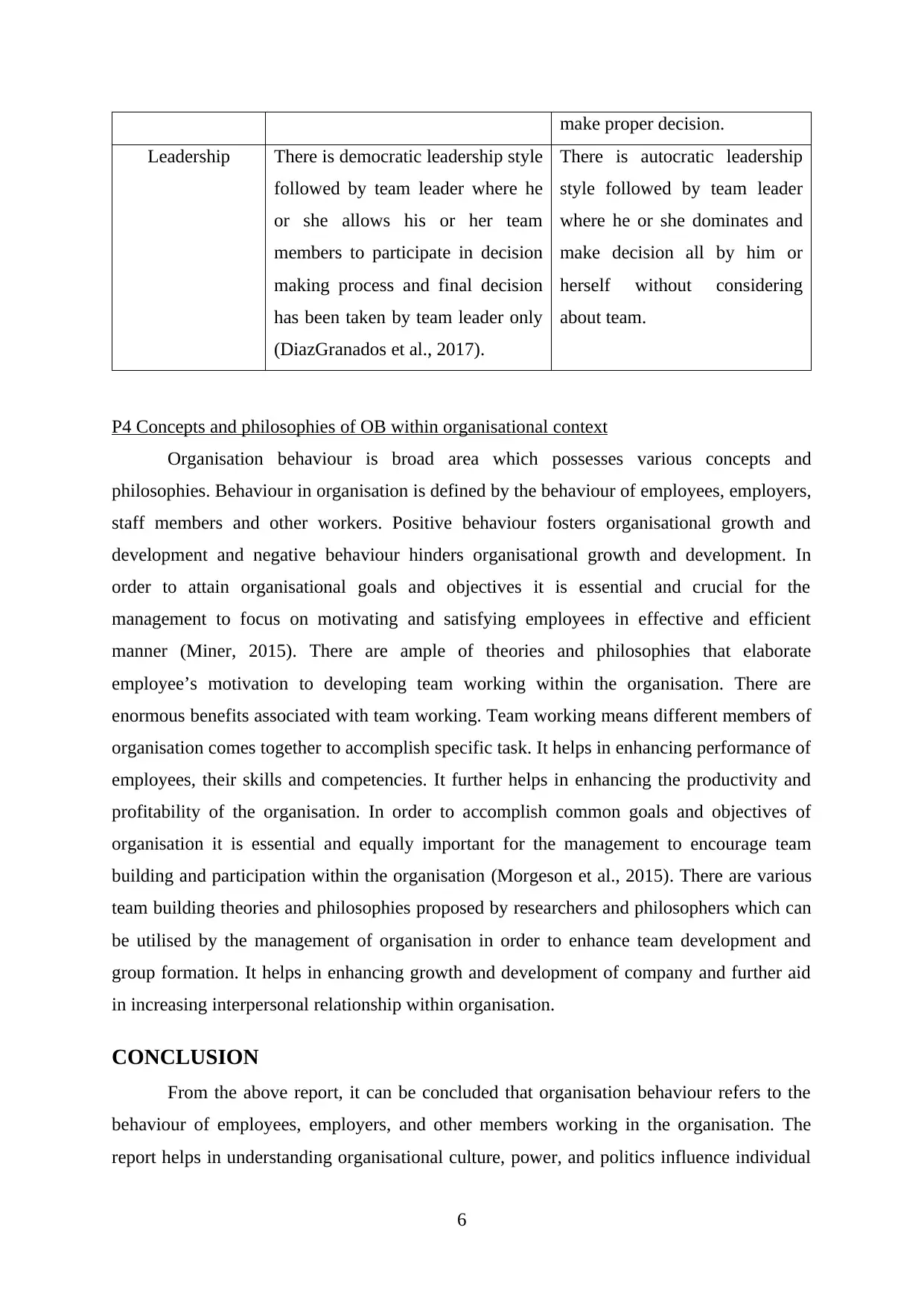
make proper decision.
Leadership There is democratic leadership style
followed by team leader where he
or she allows his or her team
members to participate in decision
making process and final decision
has been taken by team leader only
(DiazGranados et al., 2017).
There is autocratic leadership
style followed by team leader
where he or she dominates and
make decision all by him or
herself without considering
about team.
P4 Concepts and philosophies of OB within organisational context
Organisation behaviour is broad area which possesses various concepts and
philosophies. Behaviour in organisation is defined by the behaviour of employees, employers,
staff members and other workers. Positive behaviour fosters organisational growth and
development and negative behaviour hinders organisational growth and development. In
order to attain organisational goals and objectives it is essential and crucial for the
management to focus on motivating and satisfying employees in effective and efficient
manner (Miner, 2015). There are ample of theories and philosophies that elaborate
employee’s motivation to developing team working within the organisation. There are
enormous benefits associated with team working. Team working means different members of
organisation comes together to accomplish specific task. It helps in enhancing performance of
employees, their skills and competencies. It further helps in enhancing the productivity and
profitability of the organisation. In order to accomplish common goals and objectives of
organisation it is essential and equally important for the management to encourage team
building and participation within the organisation (Morgeson et al., 2015). There are various
team building theories and philosophies proposed by researchers and philosophers which can
be utilised by the management of organisation in order to enhance team development and
group formation. It helps in enhancing growth and development of company and further aid
in increasing interpersonal relationship within organisation.
CONCLUSION
From the above report, it can be concluded that organisation behaviour refers to the
behaviour of employees, employers, and other members working in the organisation. The
report helps in understanding organisational culture, power, and politics influence individual
6
Leadership There is democratic leadership style
followed by team leader where he
or she allows his or her team
members to participate in decision
making process and final decision
has been taken by team leader only
(DiazGranados et al., 2017).
There is autocratic leadership
style followed by team leader
where he or she dominates and
make decision all by him or
herself without considering
about team.
P4 Concepts and philosophies of OB within organisational context
Organisation behaviour is broad area which possesses various concepts and
philosophies. Behaviour in organisation is defined by the behaviour of employees, employers,
staff members and other workers. Positive behaviour fosters organisational growth and
development and negative behaviour hinders organisational growth and development. In
order to attain organisational goals and objectives it is essential and crucial for the
management to focus on motivating and satisfying employees in effective and efficient
manner (Miner, 2015). There are ample of theories and philosophies that elaborate
employee’s motivation to developing team working within the organisation. There are
enormous benefits associated with team working. Team working means different members of
organisation comes together to accomplish specific task. It helps in enhancing performance of
employees, their skills and competencies. It further helps in enhancing the productivity and
profitability of the organisation. In order to accomplish common goals and objectives of
organisation it is essential and equally important for the management to encourage team
building and participation within the organisation (Morgeson et al., 2015). There are various
team building theories and philosophies proposed by researchers and philosophers which can
be utilised by the management of organisation in order to enhance team development and
group formation. It helps in enhancing growth and development of company and further aid
in increasing interpersonal relationship within organisation.
CONCLUSION
From the above report, it can be concluded that organisation behaviour refers to the
behaviour of employees, employers, and other members working in the organisation. The
report helps in understanding organisational culture, power, and politics influence individual
6
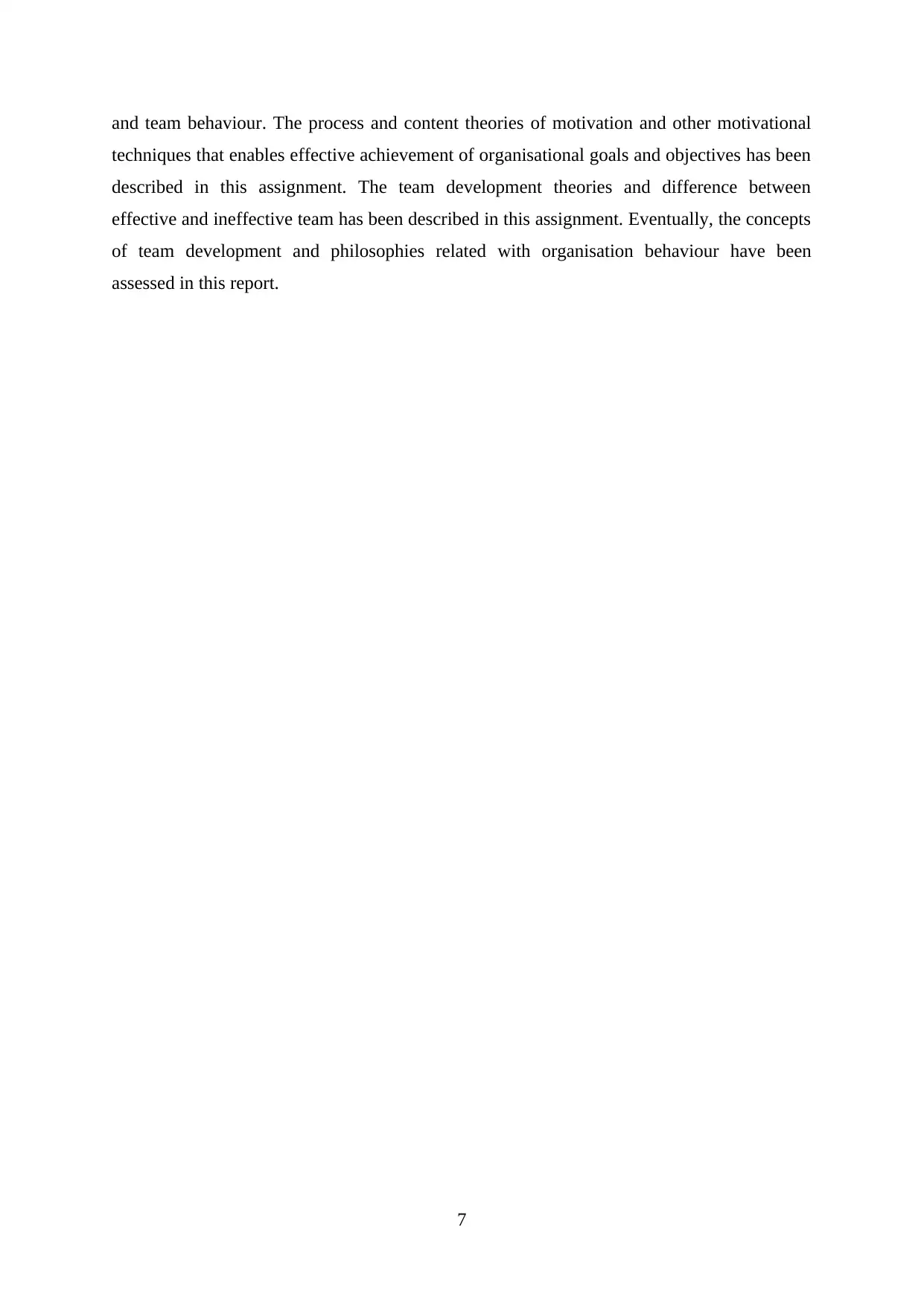
and team behaviour. The process and content theories of motivation and other motivational
techniques that enables effective achievement of organisational goals and objectives has been
described in this assignment. The team development theories and difference between
effective and ineffective team has been described in this assignment. Eventually, the concepts
of team development and philosophies related with organisation behaviour have been
assessed in this report.
7
techniques that enables effective achievement of organisational goals and objectives has been
described in this assignment. The team development theories and difference between
effective and ineffective team has been described in this assignment. Eventually, the concepts
of team development and philosophies related with organisation behaviour have been
assessed in this report.
7
⊘ This is a preview!⊘
Do you want full access?
Subscribe today to unlock all pages.

Trusted by 1+ million students worldwide
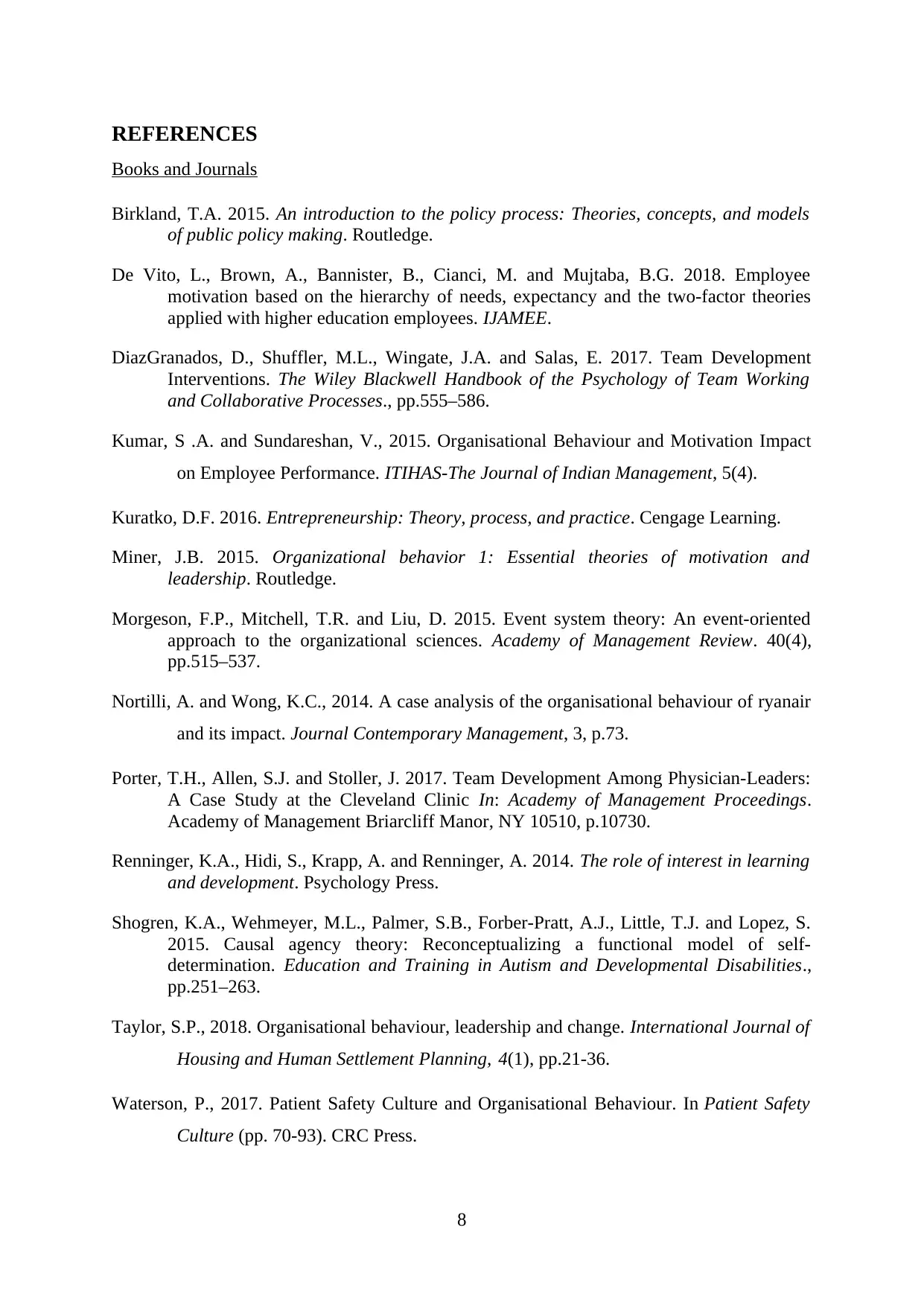
REFERENCES
Books and Journals
Birkland, T.A. 2015. An introduction to the policy process: Theories, concepts, and models
of public policy making. Routledge.
De Vito, L., Brown, A., Bannister, B., Cianci, M. and Mujtaba, B.G. 2018. Employee
motivation based on the hierarchy of needs, expectancy and the two-factor theories
applied with higher education employees. IJAMEE.
DiazGranados, D., Shuffler, M.L., Wingate, J.A. and Salas, E. 2017. Team Development
Interventions. The Wiley Blackwell Handbook of the Psychology of Team Working
and Collaborative Processes., pp.555–586.
Kumar, S .A. and Sundareshan, V., 2015. Organisational Behaviour and Motivation Impact
on Employee Performance. ITIHAS-The Journal of Indian Management, 5(4).
Kuratko, D.F. 2016. Entrepreneurship: Theory, process, and practice. Cengage Learning.
Miner, J.B. 2015. Organizational behavior 1: Essential theories of motivation and
leadership. Routledge.
Morgeson, F.P., Mitchell, T.R. and Liu, D. 2015. Event system theory: An event-oriented
approach to the organizational sciences. Academy of Management Review. 40(4),
pp.515–537.
Nortilli, A. and Wong, K.C., 2014. A case analysis of the organisational behaviour of ryanair
and its impact. Journal Contemporary Management, 3, p.73.
Porter, T.H., Allen, S.J. and Stoller, J. 2017. Team Development Among Physician-Leaders:
A Case Study at the Cleveland Clinic In: Academy of Management Proceedings.
Academy of Management Briarcliff Manor, NY 10510, p.10730.
Renninger, K.A., Hidi, S., Krapp, A. and Renninger, A. 2014. The role of interest in learning
and development. Psychology Press.
Shogren, K.A., Wehmeyer, M.L., Palmer, S.B., Forber-Pratt, A.J., Little, T.J. and Lopez, S.
2015. Causal agency theory: Reconceptualizing a functional model of self-
determination. Education and Training in Autism and Developmental Disabilities.,
pp.251–263.
Taylor, S.P., 2018. Organisational behaviour, leadership and change. International Journal of
Housing and Human Settlement Planning, 4(1), pp.21-36.
Waterson, P., 2017. Patient Safety Culture and Organisational Behaviour. In Patient Safety
Culture (pp. 70-93). CRC Press.
8
Books and Journals
Birkland, T.A. 2015. An introduction to the policy process: Theories, concepts, and models
of public policy making. Routledge.
De Vito, L., Brown, A., Bannister, B., Cianci, M. and Mujtaba, B.G. 2018. Employee
motivation based on the hierarchy of needs, expectancy and the two-factor theories
applied with higher education employees. IJAMEE.
DiazGranados, D., Shuffler, M.L., Wingate, J.A. and Salas, E. 2017. Team Development
Interventions. The Wiley Blackwell Handbook of the Psychology of Team Working
and Collaborative Processes., pp.555–586.
Kumar, S .A. and Sundareshan, V., 2015. Organisational Behaviour and Motivation Impact
on Employee Performance. ITIHAS-The Journal of Indian Management, 5(4).
Kuratko, D.F. 2016. Entrepreneurship: Theory, process, and practice. Cengage Learning.
Miner, J.B. 2015. Organizational behavior 1: Essential theories of motivation and
leadership. Routledge.
Morgeson, F.P., Mitchell, T.R. and Liu, D. 2015. Event system theory: An event-oriented
approach to the organizational sciences. Academy of Management Review. 40(4),
pp.515–537.
Nortilli, A. and Wong, K.C., 2014. A case analysis of the organisational behaviour of ryanair
and its impact. Journal Contemporary Management, 3, p.73.
Porter, T.H., Allen, S.J. and Stoller, J. 2017. Team Development Among Physician-Leaders:
A Case Study at the Cleveland Clinic In: Academy of Management Proceedings.
Academy of Management Briarcliff Manor, NY 10510, p.10730.
Renninger, K.A., Hidi, S., Krapp, A. and Renninger, A. 2014. The role of interest in learning
and development. Psychology Press.
Shogren, K.A., Wehmeyer, M.L., Palmer, S.B., Forber-Pratt, A.J., Little, T.J. and Lopez, S.
2015. Causal agency theory: Reconceptualizing a functional model of self-
determination. Education and Training in Autism and Developmental Disabilities.,
pp.251–263.
Taylor, S.P., 2018. Organisational behaviour, leadership and change. International Journal of
Housing and Human Settlement Planning, 4(1), pp.21-36.
Waterson, P., 2017. Patient Safety Culture and Organisational Behaviour. In Patient Safety
Culture (pp. 70-93). CRC Press.
8
Paraphrase This Document
Need a fresh take? Get an instant paraphrase of this document with our AI Paraphraser
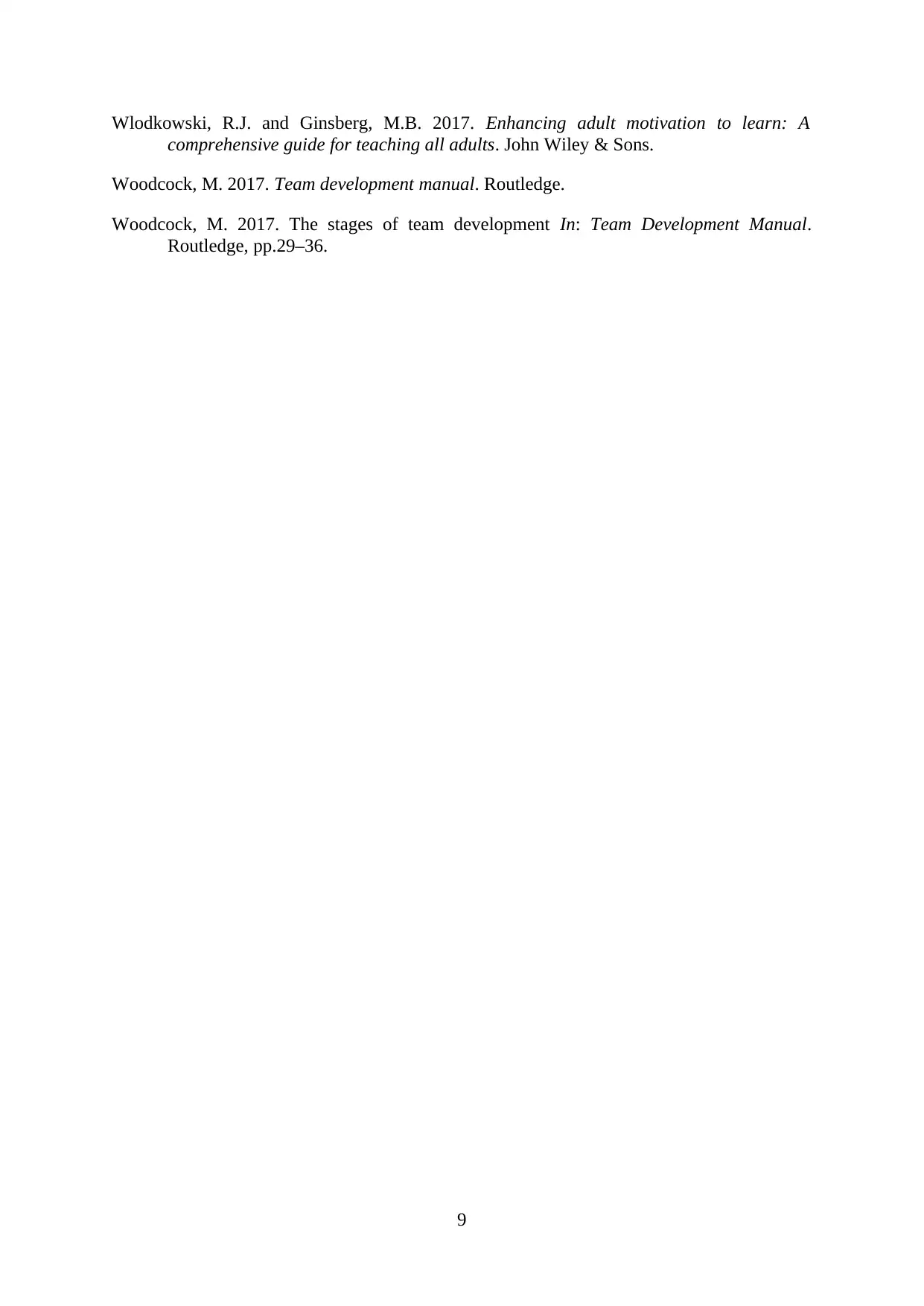
Wlodkowski, R.J. and Ginsberg, M.B. 2017. Enhancing adult motivation to learn: A
comprehensive guide for teaching all adults. John Wiley & Sons.
Woodcock, M. 2017. Team development manual. Routledge.
Woodcock, M. 2017. The stages of team development In: Team Development Manual.
Routledge, pp.29–36.
9
comprehensive guide for teaching all adults. John Wiley & Sons.
Woodcock, M. 2017. Team development manual. Routledge.
Woodcock, M. 2017. The stages of team development In: Team Development Manual.
Routledge, pp.29–36.
9
1 out of 11
Related Documents
Your All-in-One AI-Powered Toolkit for Academic Success.
+13062052269
info@desklib.com
Available 24*7 on WhatsApp / Email
![[object Object]](/_next/static/media/star-bottom.7253800d.svg)
Unlock your academic potential
Copyright © 2020–2025 A2Z Services. All Rights Reserved. Developed and managed by ZUCOL.





